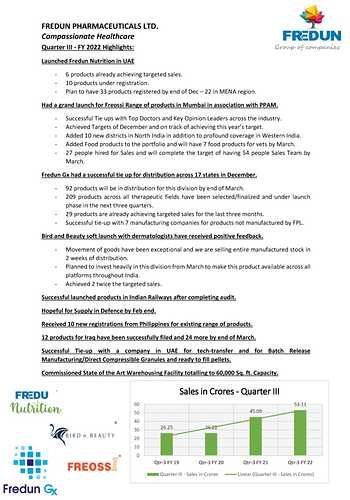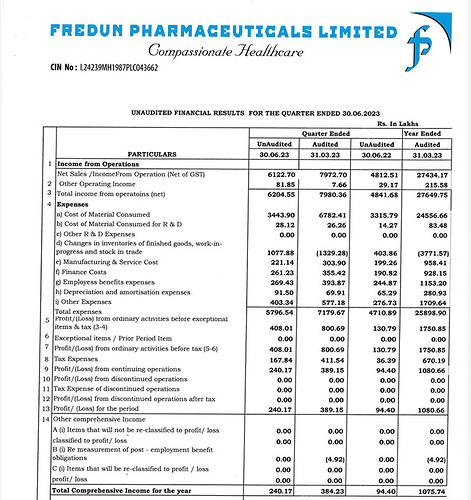Fredun Pharmaceuticals was started in the 90’s and was originally a contract manufacturing company , it has grown and come a long way and now contract manufacturing is only about 2% of the sales of the company which have frown at:
FINANCIALS
|10 Years:|37.73%|5 Years:|35.45%||3 Years:|31.93%||TTM:|39.54%|
Compounded Profit Growth
10 Years: 53.86%-5 Years: 79.40%-3 Years: 58.98%-TTM: -31.14%
the Product portfolio Anti-diabetic ingredients contribute 25% of its total sales, anti-cardiac 18%, NSAID 24% and others 33%
The company has expanded production capacity by 530% in last few years. It has been systematically investing in its productive infrastructure by installing additional granulation departments, high-speed tableting and blister packing machines. The current capacity utilisation is at 50% and it is projected to go up to 80% by mid-2020.
Read more at:
Risk Analysis qualitative and quantitative ( As far as my capability allows)
Getting at the numbers , the company looks interesting and reminds me a bit of caplinpoint Labs, its targeting non US markets like Vietnam, Thailand,Turkey,Shri Lanka, Tunisania,Myanamar,Malaysia ,Combodia,Phillipenes,Mauritus to name a few and a lot of countries within Africa.
So I’m looking into the fact that does India have a structural advantage in Pharma over these countries , be a labour cost , Know how , and where exactly in the value chain does the generic Pharma company in India separate itself from those in other countries. The fact that we are one of the biggest generic players globally we can assume that there is an innate competitive advantage we have, that being said the African Market looks like a very good opportunity gives the fact that Fredun is targeting niche markets with niche verticals and has a good mix of high volume and margin products ( I have a pet dog and taking him to the vet I noticed one of their products that if I recall have seen pretty often, its in their vet nary vertical) .
Coming to the numbers the market cap is 65cr and if I average out the cash from operating actives after working capital enough to maintain current sales level giving a no growth outlook, the cash yield (Operating profit-( maintenance working capital+mainiance capex-tax)) yield comes to about 6 cr, with the current market cap of 65cr the yield is about 6/65= 9.25 yield , so if we can look at it like a callable bond , its a company assuming it does not grow anymore and decides to start paying out the money it generates now its a 9.2% yield(assuming current status co), but if someone can help me dive deeper into it and answer the following questions maybe we can get a better idea about the probability oft he future growth and margins, so far the management seems to suggest a 20-30% cagr. If that comes true its like bond yielding 9% growing at 20% cagr, the downside seems very protected if the company can even maintain status quo and not grow, but the growth I feel if it comes can generate very good returns considering we are barely paying anything for growth .
The only key risk I see that may drive the current 9% yield is 1) if sales de grow and the company must still pay its fixed costs on the unutilised capacities 2) No pricing power in the situation raw material costs go up, though so far margins have mostly improved.
Answers to the below questions will be very welcome, but points made supported by evidence would be really helpful and not inferred opinions, I’m trying to get facts here so everyone can gauge and infer the data presented as they need to and then we can debate the rest.
If we can see what is the estimated market size in each of the verticals they operate in , in the respective countries they are present in and what are the local and other competitors in those markets.
There is not much information from the management perspective , but if we can try and see if there is a moat something that distinguishes them since its a semi commoditized space ( some verticals not all) and where in the value chain that is present, cheaper working capital, faster inventory turnover? Processing efficiency due to automaton , cheaper sourcing of raw material any other things pls feel free to write, though I’m a lone wolf , Pharma is not my best sector so I though of writing about Frendun here since it does remind me allot of caplin in its early days given the target market and seeing the larger picture , they have also developed some medicines for the Indian market and bidding for government tenders ,and the big health care push coming from the government that is another space they are already preparing themselves for. Saying all this if we can figure out the odds and what the likely hood of the growth going ahead could be a very rewarding , also they have enough capacity to do a top line of 230 cr without further need for capex , current revenue is about 120 cr ttm
Disclosure : No holdings yet, but tracking carefully.




